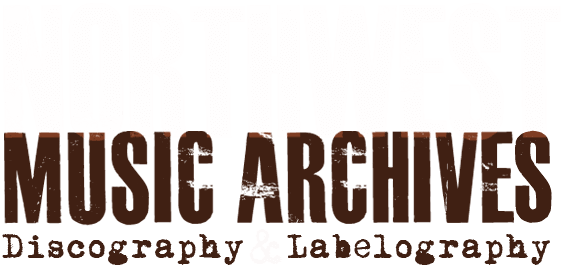

THE NORTHWEST MUSIC ARCHIVES documents audio recordings produced in the Pacific Northwest area of North America. We present data as labelographies (by using our “Search by Label” function) that note what recordings were issued when by which labels — and also (by using our “Search by Artist” function) as discographies that reveal what recordings were created when by which local musicians.
AUDIO HISTORY: To gain a greater sense of the deep back-story of our main topic, please click on our NW History page. It includes links to essays covering topics including the first record ever cut in Seattle and an overview of recording history in the Northwest.
CONTACT: We welcome the contribution of relevant discographical data from fellow music fans, musicians, and labels. Please submit info (or recordings) via our Archives Facebook page.
————————————DATABASE BASICS——————————————
SOUND CARRIER FORMATS: This site notes the different “sound carrier formats” (and their varying configurations) that recordings were released in. They include discs (16 rpm, 33 1/3 rpm, 45 rpm,& 78 rpm), player-piano rolls, reel-to-reel tapes, cassettes, 8-track cartridges, compact discs (CD), and even digital downloads.
SERIAL NUMBER: A record’s Serial Number (or “Catalog Number”) is typically found in relatively large type-font on the paper label at the center of a disc, and will typically be the same number on both sides of that disc. It is intended as the record company’s means of organizing the sequence in which their various recordings are produced and/or released. Cassettes and CDs likewise have Serial Numbers noted on them.
MATRIX NUMBER: A Matrix Number is an alphanumeric code that is often printed on a record’s paper label (but it is typically in a smaller type-font than the Serial Number). A Matrix Number is intended for the internal use of the manufacturing plant — mainly to assign a filing/storage number for the metal disc-stamper — but they can also provide useful information to discographers about the edition of the record, and/or when it was pressed.
STAMPER CODE: A Stamper Code is an alphanumeric code stamped (or hand-etched) into the run-out area of a disc (the non-grooved area between the final band on a disc’s side and the paper label). There are typically two parts to Stamper Codes: the Serial Number (or Matrix Number), and extra information which can include a “take” number (reflecting which rendition of a song, among several the artist may have recorded during a session, was selected for release). It may also include disc pressing-plant codes or logos, the initials or signature of the disc-cutting engineer, and cutting or copyright dates. California’s Monarch plant employed what is called a “Delta Code” — a number preceded by a pyramid-shaped symbol (which this site denotes with a ^ digit) that can be helpful in dating when that disc was pressed.
DATES: Listed dates on this site are generally record release dates, rather than recording session dates (as the latter are not generally documented for most recordings in recent decades). All noted dates are presented in the Year-Month-Day format of YY-MM-DD. [Example: for a recording released on January 21, 2014, our site would show 2014-01-21]
SONG PUBLISHERS: Publishing companies are noted if they are listed on a recording’s label — as are various performing rights organizations that they were associated with, including ASCAP (the American Society of Composers, Authors and Publishers) and BMI (Broadcast Music, Inc.).
————————————————————————————————
———————-ABOUT US: THE TEAM BEHIND THIS WEBSITE———————-
 PETE BLECHA launched the original Northwest Music Archives in 1982 as an independent historical preservation project which produced free public exhibits around Seattle relating the history of the region’s recording industry. In 1983 he began years of penning the path-breaking “Northwest Archives” history column in The Rocket magazine. He also served for a few years on the Northwest Area Music Association’s Hall of Fame Committee. Then, after spinning rare local discs as a radio DJ at KCMU, he served for 8.5 years as Senior Curator at Seattle’s music museum, the Experience Music Project (today’s Museum of Pop Culture, MoPop). A long-time member of the Pacific Northwest Historians Guild, and the Association for Recorded Sound Collections (and has served several terms on their Excellence in Publications Committee), he is the multiple award-winning author of twelve books, and has served as a Staff Historian & Contributing Editor for Washington State’s online history encyclopedia, HistoryLink.org since 2001. He can be reached via our NW MUSIC ARCHIVES FaceBook Page.
PETE BLECHA launched the original Northwest Music Archives in 1982 as an independent historical preservation project which produced free public exhibits around Seattle relating the history of the region’s recording industry. In 1983 he began years of penning the path-breaking “Northwest Archives” history column in The Rocket magazine. He also served for a few years on the Northwest Area Music Association’s Hall of Fame Committee. Then, after spinning rare local discs as a radio DJ at KCMU, he served for 8.5 years as Senior Curator at Seattle’s music museum, the Experience Music Project (today’s Museum of Pop Culture, MoPop). A long-time member of the Pacific Northwest Historians Guild, and the Association for Recorded Sound Collections (and has served several terms on their Excellence in Publications Committee), he is the multiple award-winning author of twelve books, and has served as a Staff Historian & Contributing Editor for Washington State’s online history encyclopedia, HistoryLink.org since 2001. He can be reached via our NW MUSIC ARCHIVES FaceBook Page.
- R. BRUCE SMITH is a historian and the pioneering discographer of local recordings who — way back in 1975! — founded Seattle’s invaluable Northwest Disc-Coveries & Sound Report, the long-running news magazine of recording arts & pro sound in the Pacific Northwest. Record-wise, he was once told “You are not a collector, you are an archivist.” His early writings on the history of Northwest record companies documented much previously unpublished information and set the standard in this region. He can be reached via email at: 19bruba46@gmail.com
- DUSTIN HAYS runs the ultra-cool Julianrecords.com online archive honoring the Julian label that was active in his hometown area, the Wenatchee Valley — the “Apple Capital of the World” — throughout the 1960s. In 2017 he curated the Apple Capital Records exhibit with the Wenatchee Valley Museum and Cultural Center. The exhibit focused on the groups and venues that have operated in the area since the late 1800s. He writes a monthly column “B-SIDES” about Wenatchee music history for The Comet Magazine. He recently co-authored the book Rotten To the Core: Relics of Wenatchee Rock ‘n’ Roll 1990-1999 with fellow Wenatchee musician Matthew Smith. He can be reached via email at julianrecordsinfo@gmail.com.
- ROD MOODY is a longtime Seattle-area musician, writer, editor, and researcher. Born and raised in West Seattle, he began playing music at the age of four, and composed his first song “Heck, Heck, Heck”, at age six. He has played in no less than twenty bands during his forty years as an active musician, including Swallow, The Fuzz, Swedish Finnish, and Deranged Diction. In the mid-’90s, he became proofing lead for Microsoft’s comprehensive music encyclopedia (CD-ROM), Music Central, which led to an editorial/writing role as the software giant launched its first music website. He also contributed to local ‘zine Backfire / Backlash, served as web editor for the New England Historic Genealogical Society, and until recently, worked as web and social media director for Easy Street Records. One of the perks from the latter job was the honor of sitting in with The Sonics when they played their legendary 2015 Record Store Day in-store gig at Easy Street. In his spare time, he likes to research his hometown of West Seattle. He recently launched Historic West Seattle Junction, which compiles a detailed history of businesses in the West Seattle Junction from the 1920s to the present…
- KATE RACE is a dynamic graphic & website designer – and fine artist – who operates an independent design enterprise, katracedesign.
- MILES MATSUMOTO is a principal at Tiny Whale Creative, a graphic designer and computer code ace — & the dude responsible for creating the logo for The Matrix movies.